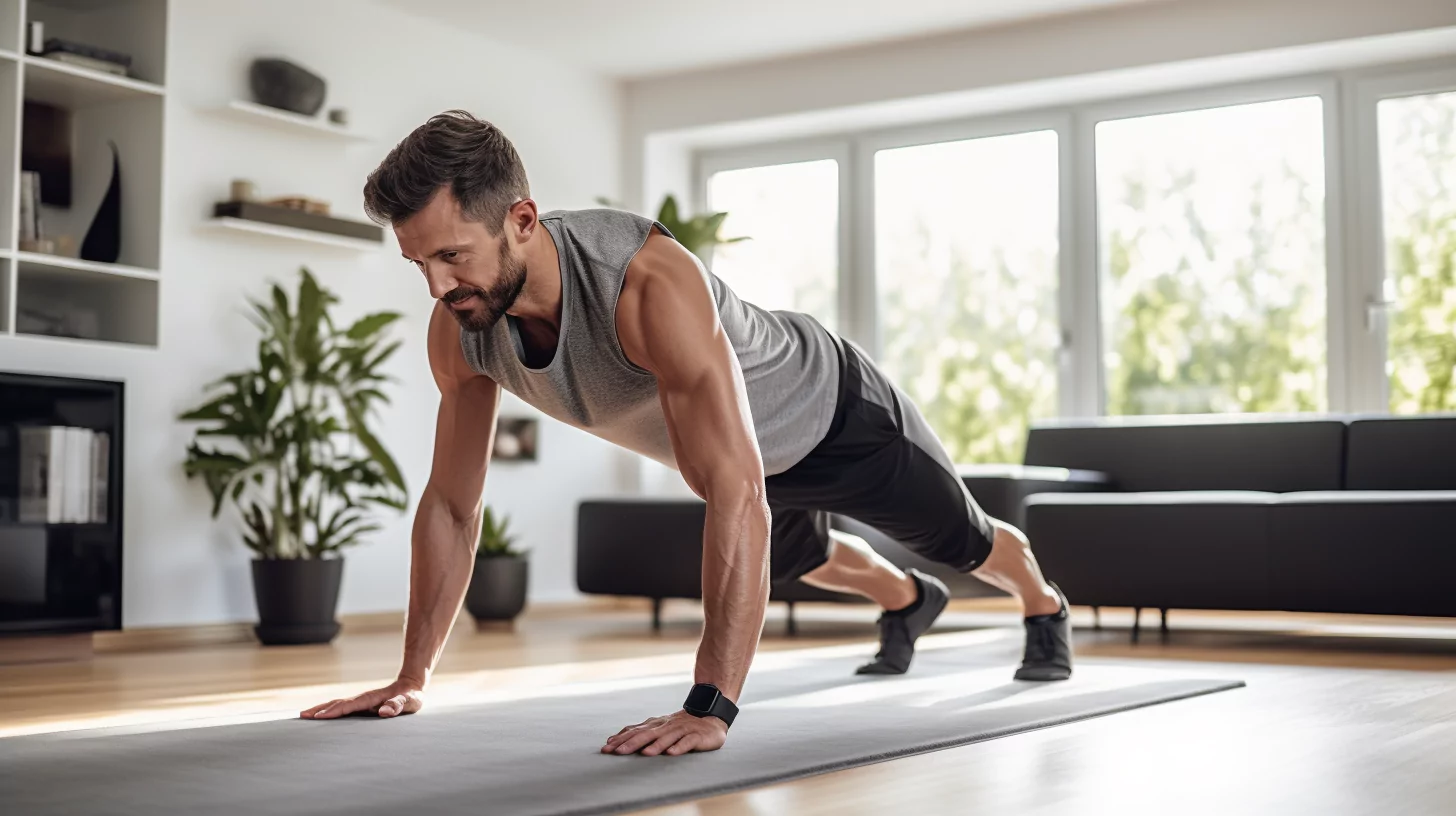There’s an endless sea of workout routines out there—strength training, cardio, HIIT, and what have you. And sometimes, says Ronan Diego, the head of Mindvalley’s Health & Fitness and trainer of the 10x Fitness Quest, “you don’t know what you need to do.”
Plus, if you’re starting off, the equipment, the jargon, and all that goes along with it can be intimidating. What’s more, if you’ve got a million things happening every day, heading to the gym can be far from your first choice.
There is one solution you can consider—that’s bodyweight exercises. The best part is, they can be easily done anywhere, anytime, with no need for special equipment. All you need is your own body and a little motivation.
What are bodyweight exercises?
Chances are, you’ve heard of squats, lunges, push-ups, and pull-ups—these are all examples of calisthenics, bodyweight exercises that require little or no equipment. Instead, they harness your own body weight as resistance to build strength, endurance, and power.
Even research backs this up. One study, in particular, found that doing simple bodyweight exercises can make your heart and lungs healthier.
This means that you can get fitter even with short and easy workouts (much like what Mindvalley’s 10X Fitness program is about). And that can be incredibly ideal for people who don’t have much time or special equipment…or even those who prefer a free workout.
The 10x way
The thing with traditional fitness is, as Ronan explains, that they’re not “built in a progression.” The programs are often generic, and the exercises? Disconnected.
The 10x Fitness approach, on the other hand, leverages the power of the adaptive response, a biological principle where your body adjusts to challenges and stressors by becoming stronger and more resilient.
Here’s how it works: As you master bodyweight resistance training and build strength, the program automatically introduces variations or progressions, keeping you challenged and stimulated. This continuous adaptation ensures your body keeps adapting and evolving, leading to 10x faster and more sustainable results.
What’s more, this revolutionary system focuses on strength training as the key to unlocking overall fitness. Why? Because strength training impacts various aspects of health:
- It boosts muscle mass. Muscle tissue burns more calories, even at rest, leading to a faster metabolism and improved body composition.
- It improves cardiovascular fitness by combining exercises with circuit training. This keeps your heart rate elevated for cardiovascular benefits.
- It enhances mobility. Exercises with a full range of motion improve flexibility and joint health.
“We built this program to be a total fitness program,” Ronan adds. “You are not only improving your strength but also your muscle mass [and] cardiovascular fitness, and your mobility in one single type of routine.”
The best of the best bodyweight exercises
There’s something called the “Big 6 Routine” in the 10x Fitness program. Essentially, it’s six fundamental bodyweight exercises that’ll give you a full-body workout.
Keep in mind that these are just foundational versions. The easier it becomes, the more you can add weights or adjust to make the workout harder.
Now, here’s a breakdown of each exercise, including its focus and execution:
1. Squat
This exercise mimics the movement of sitting down and standing back up while keeping your core engaged and your back straight. It’s meant to help strengthen your lower body, primarily targeting your quads, glutes, and hamstrings.
Here’s how to do it:
- Stand with feet shoulder-width apart, toes slightly outward.
- Lower your hips back and down as if sitting in a chair, keeping your back straight and your core engaged.
- Push through your heels to stand back up.
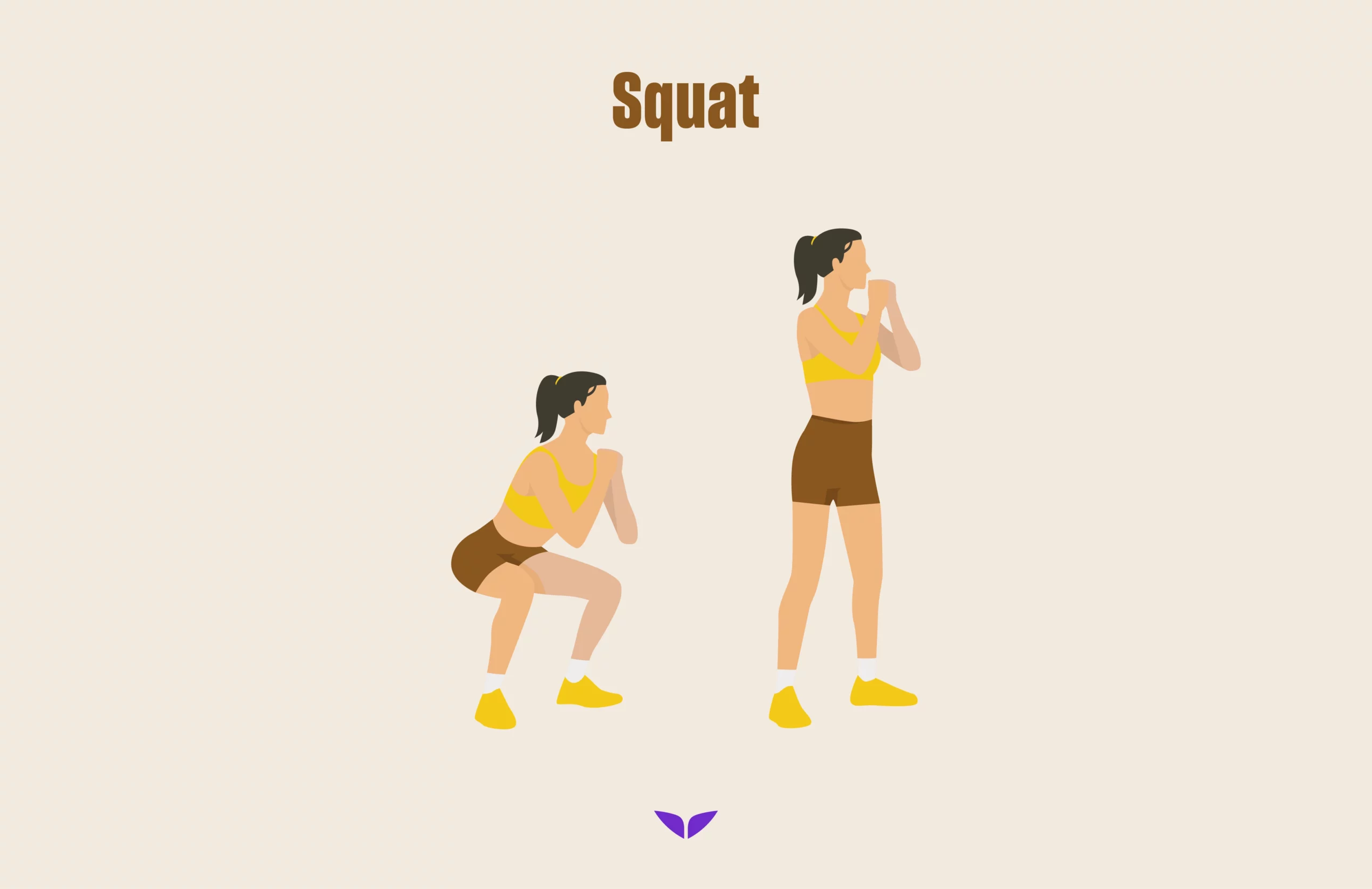
2. Pull-up/Chin-up
If you’re looking for effective arm workouts, pull-ups and chin-ups are it.
These bodyweight exercises are commonly mistaken for the same thing. However, pull-ups use an overhand grip, while chin-ups use an underhand grip.
Regardless, they both challenge your upper body, specifically your back and biceps.
Here’s how to do it:
- Hang from a bar with an overhand grip (pull-up) or underhand grip (chin-up).
- Pull your body up until your chin is above the bar.
- Lower yourself back down with control.
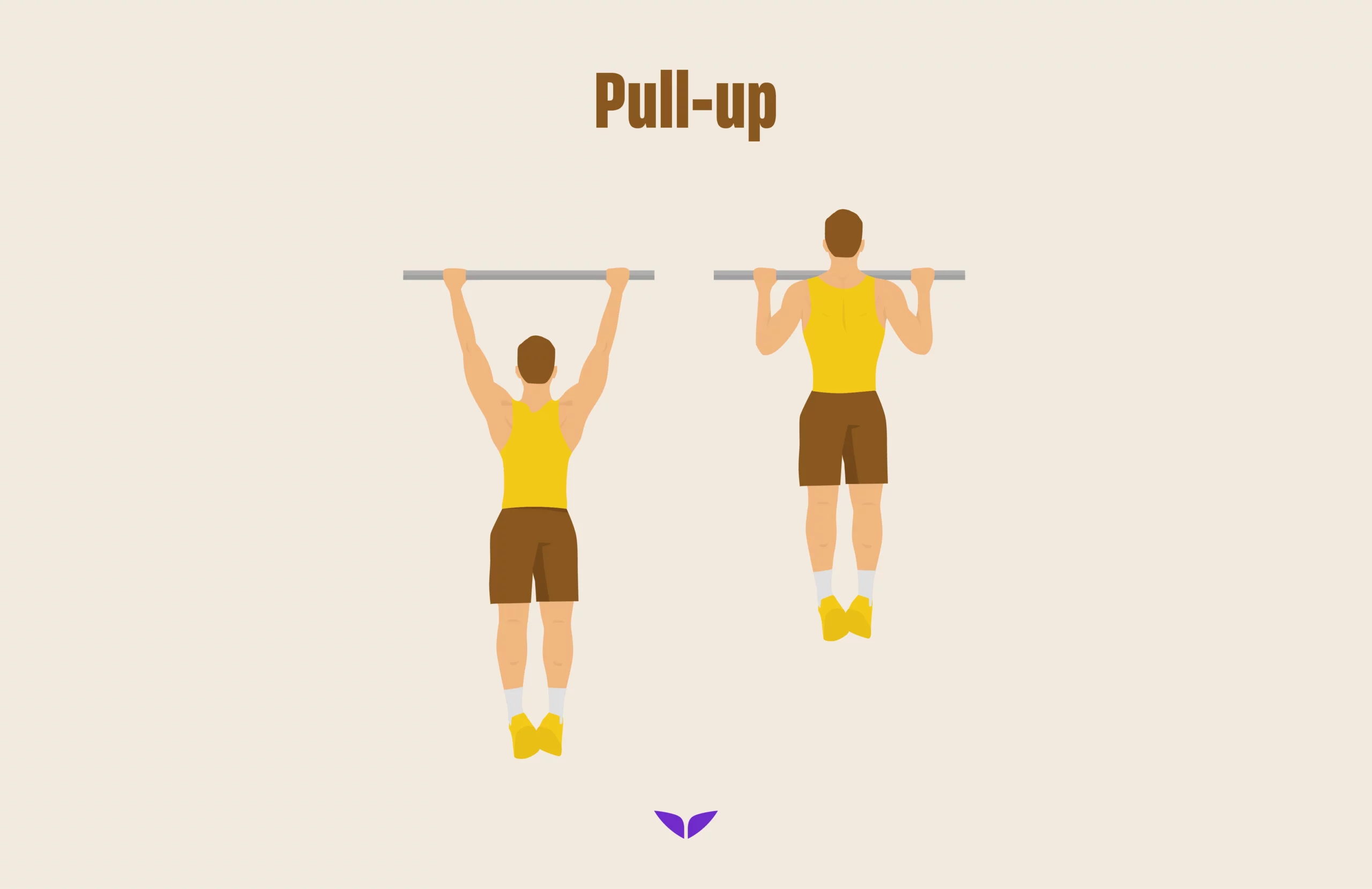
3. Push-up
From P.E. class to basic training, “Get down and give me 20!” is the universal call to push-ups, guaranteed to elicit groans and grudging respect. It’s a fundamental bodyweight exercise that works your chest, shoulders, and triceps.
Here’s how to do it:
- In a plank position with hands shoulder-width apart.
- Lower your chest towards the ground, keeping your core engaged and your back straight.
- Push yourself back up to the starting position.
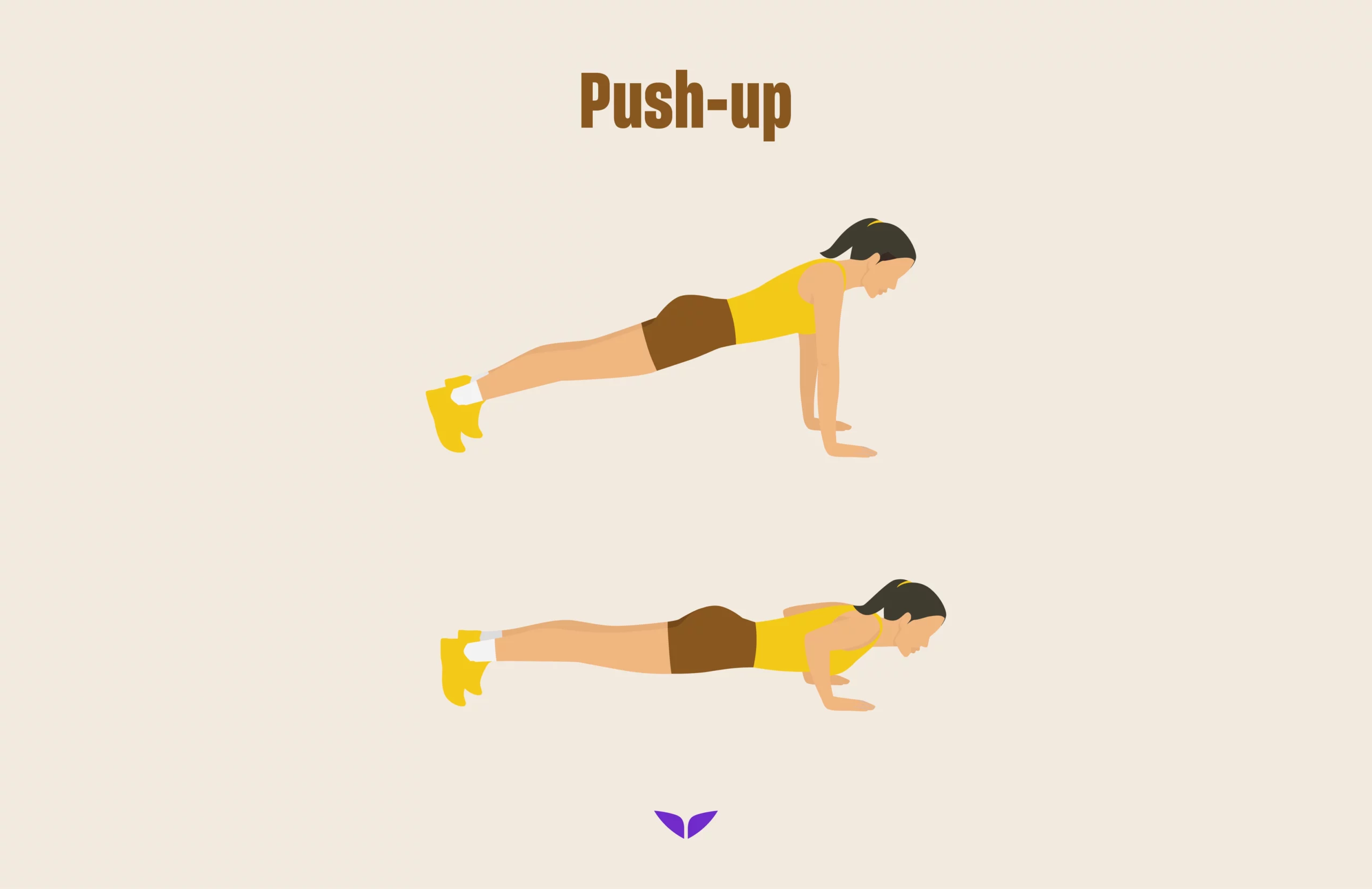
4. Hinge
It’s called “hinge” for a reason: You hinge at your hips. But what this exercise does is primarily target your posterior chain, including your hamstrings, glutes, and lower back.
Here’s how to do it (with a resistance band):
- Stand with your feet hip-width apart with a resistance band looped around your feet or a secure anchor point.
- Hinge at your hips, pushing them back and slightly bending your knees.
- Keep your back straight and your core engaged.
- Lower your torso until it’s parallel to the ground (or as close as you can comfortably reach).
- Return to the starting position.
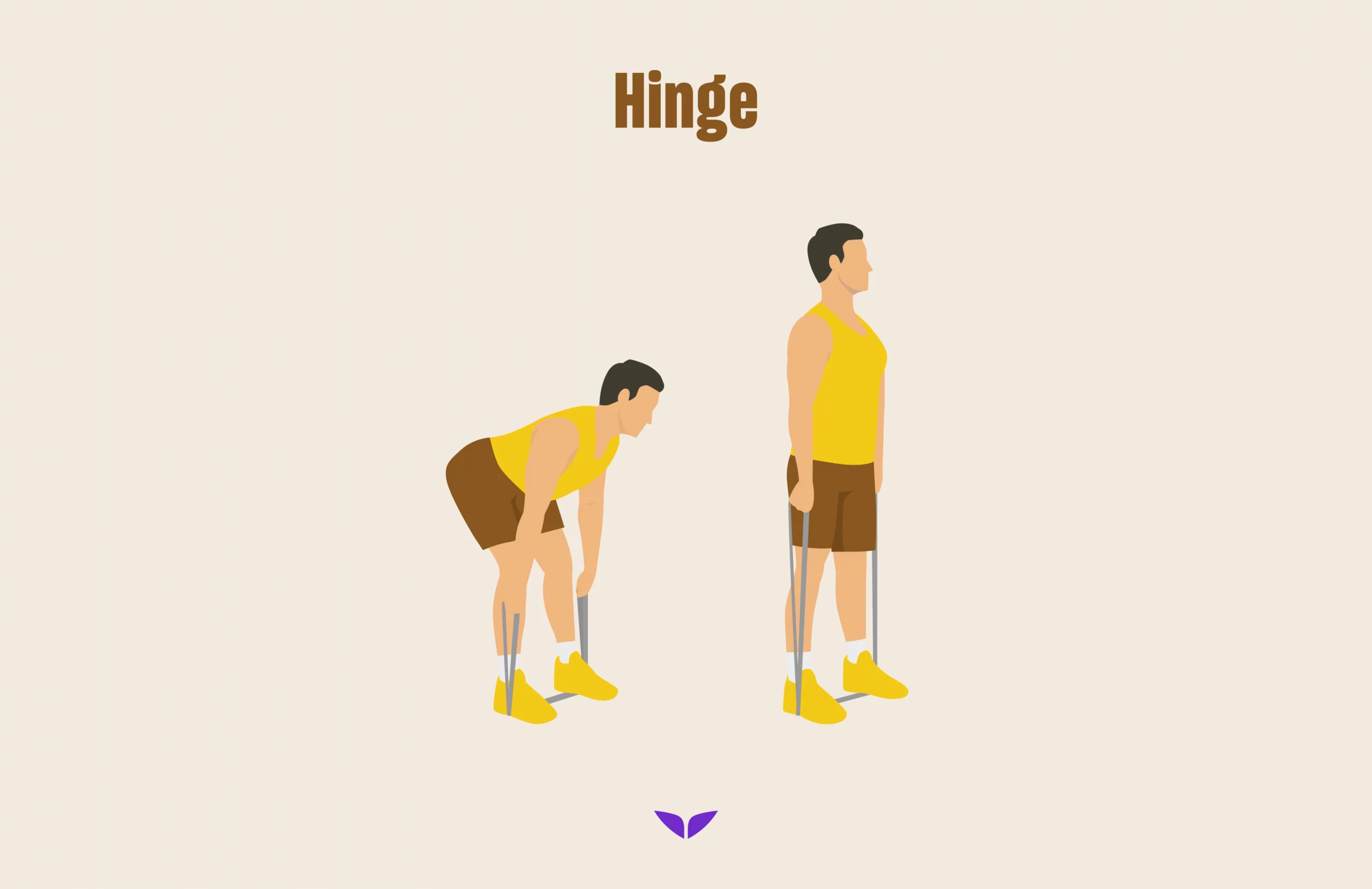
5. Row
The rowing motion replicates that of—what else?—rowing. It engages your back and biceps for everyday activities and sculpts those muscles for strength and control.
Here’s how to do it (with a resistance band):
- Stand on a stable surface with a resistance band looped around your feet or a secure anchor point.
- Hold the band’s ends with both hands, palms facing down.
- Lean forward slightly, hinging at the hips, and maintain a flat back and engaged core.
- Pull the band towards your chest, squeezing your shoulder blades together and focusing on your back muscles doing the work.
- Lower the band back down with control to the starting position.
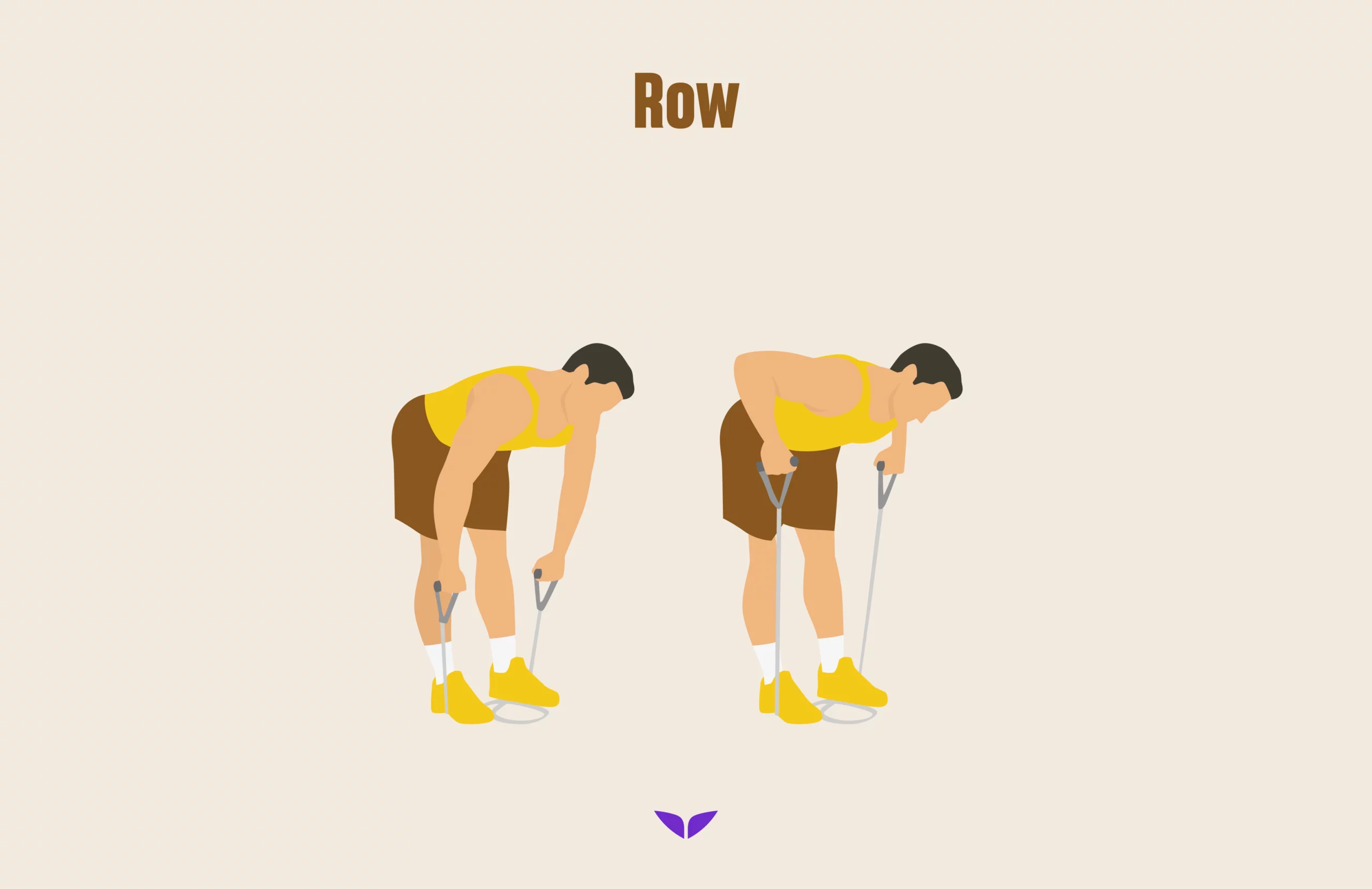
6. Press
This exercise targets the shoulders and triceps, mimicking an overhead push motion. It builds strength for dynamic movements and impressive overhead lifts.
Here’s how to do it (with a resistance band):
- Stand with your feet hip-width apart and hold your hands shoulder-width apart overhead.
- Lower your hands down towards your shoulders, keeping your elbows close to your body.
- Push your hands back up to the starting position.
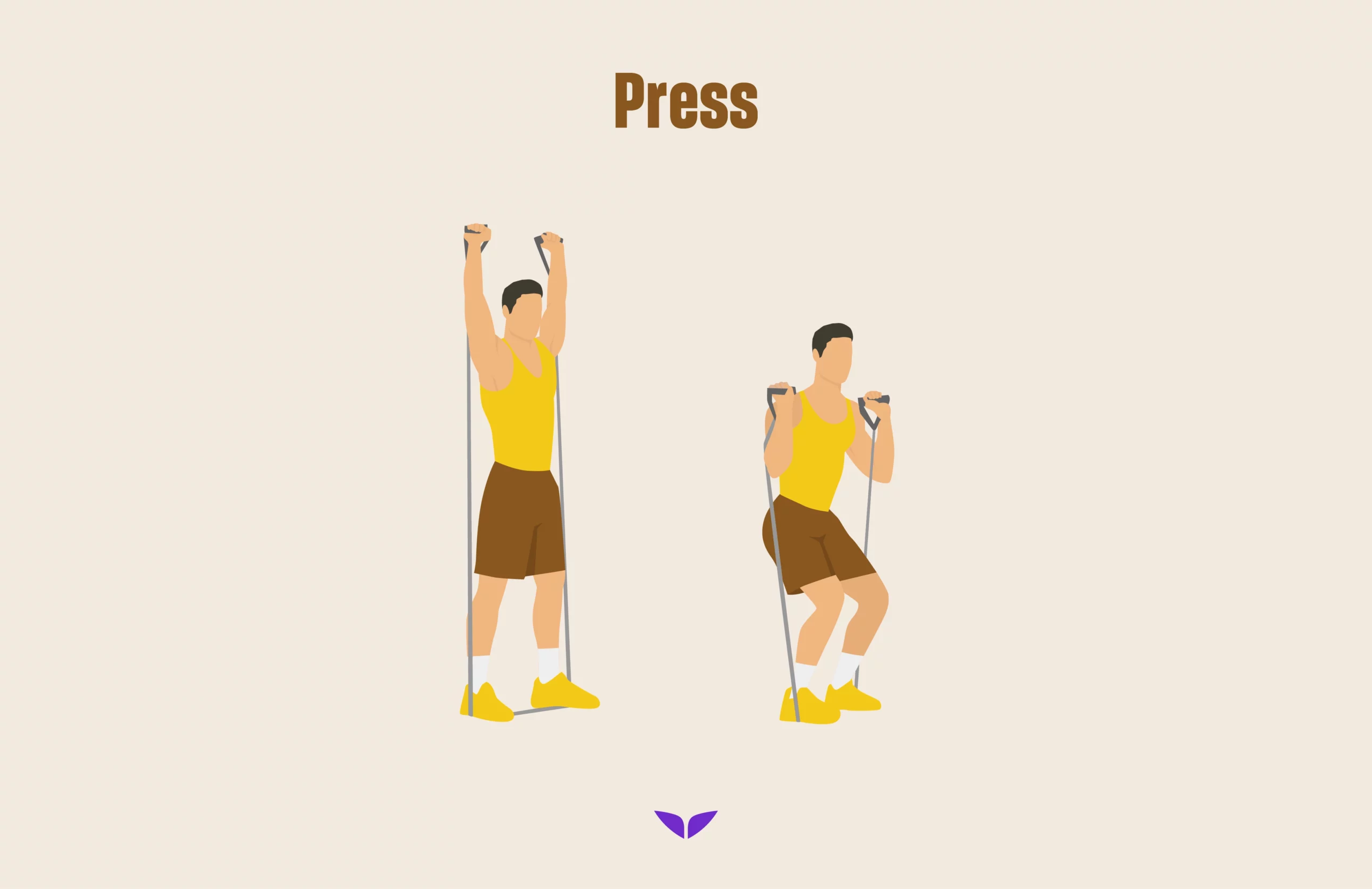
Bodyweight back exercises
Back exercises help with good posture, athletic performance, and everyday movement. These bodyweight exercises target key back muscles, building strength and stability for a sculpted and functional physique.
7. Superman
If you’re looking for an exercise without equipment, this one is the one—while making you feel like a superhero. The plus point: it helps build strength and stability in your upper and lower back.
Here’s how to do it:
- Lie face down on the ground with your arms and legs extended.
- Lift your chest, head, arms, and legs off the ground simultaneously, creating a “U” shape with your body.
- Hold for a few seconds, then slowly lower back down.
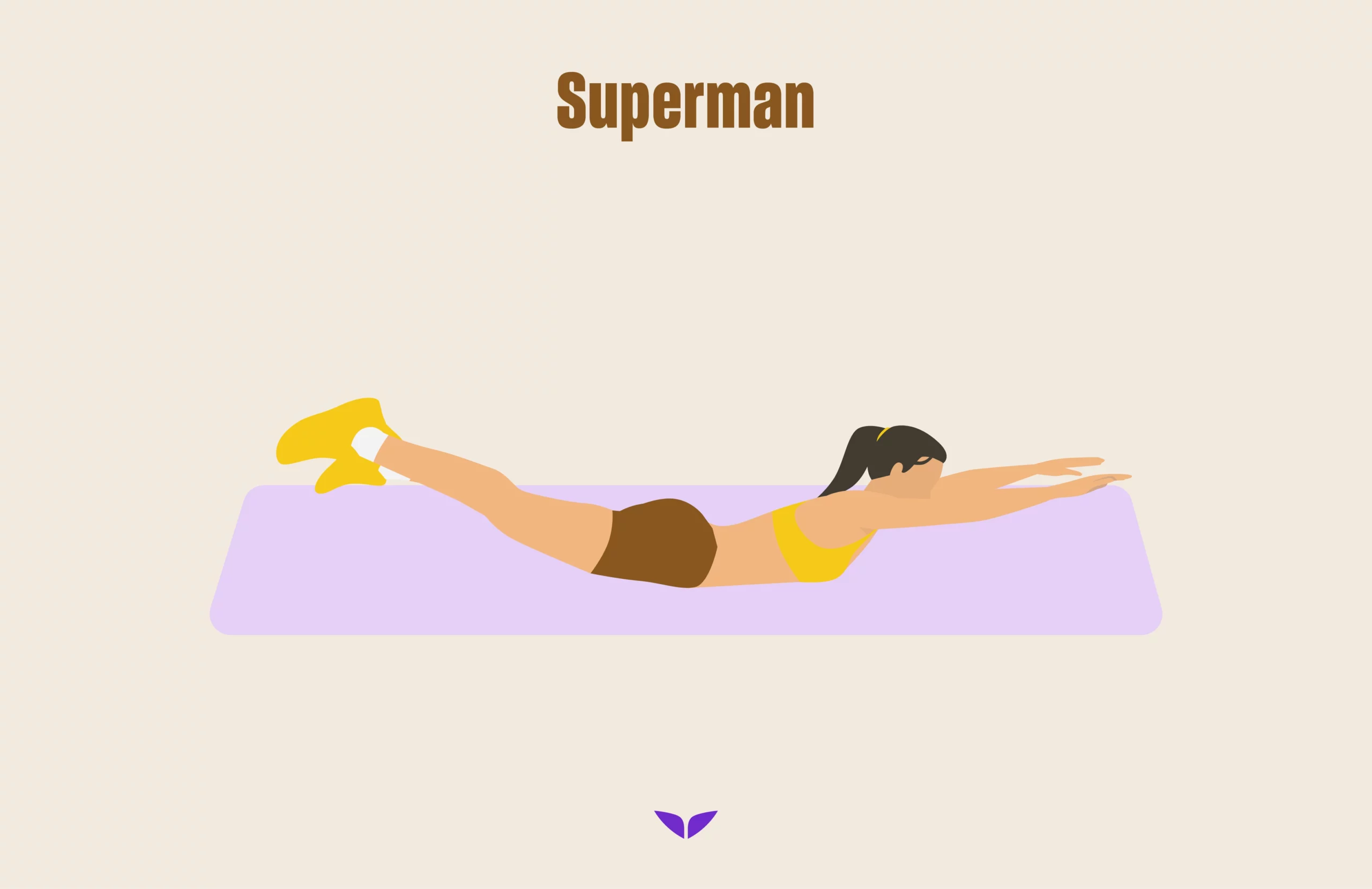
8. Glute bridge
Don’t underestimate the power of a strong rear end. This exercise activates your glutes and hamstrings while engaging your core, building a bridge to better posture and stronger movement.
Here’s how to do it:
- Lie face up with your knees bent and feet flat on the floor.
- Engage your core and glutes to lift your hips off the ground until your body forms a straight line from knees to shoulders.
- Hold for a few seconds, then slowly lower down.
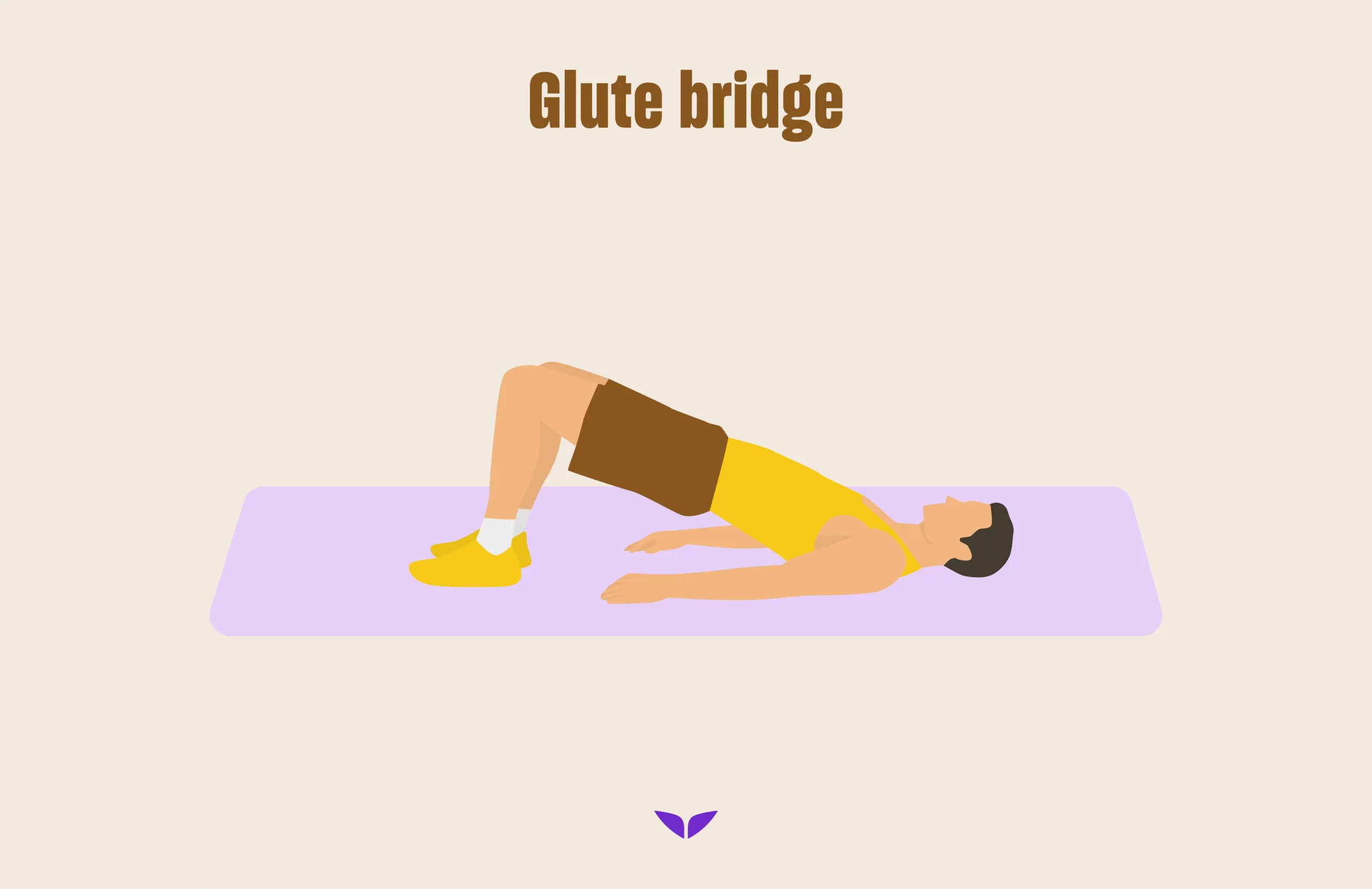
9. Inverted row
Imagine you’re a majestic eagle taking flight, squeezing your back muscles to lift your upper body. It’s this movement that’ll help strengthen your upper back, rhomboids, and traps, giving you that coveted V-shape.
Here’s how to do it:
- Lie face down on a bench or incline with your legs hanging down.
- Hold dumbbells or water bottles in your hands.
- Squeeze your back muscles to lift your upper body off the bench, keeping your core engaged and your back straight.
- Lower back down with control.

10. Wall push-up
Push-ups are iconic, but not everyone can do them on the floor. This variation using a wall offers a gentler option that still works your chest, shoulders, and triceps. Plus, it’s a perfect home workout as it doesn’t take up much space.
Here’s how to do it:
- Face a wall, hands shoulder-width apart.
- Lean in, lower chest towards the wall.
- Engage your core and push back up.
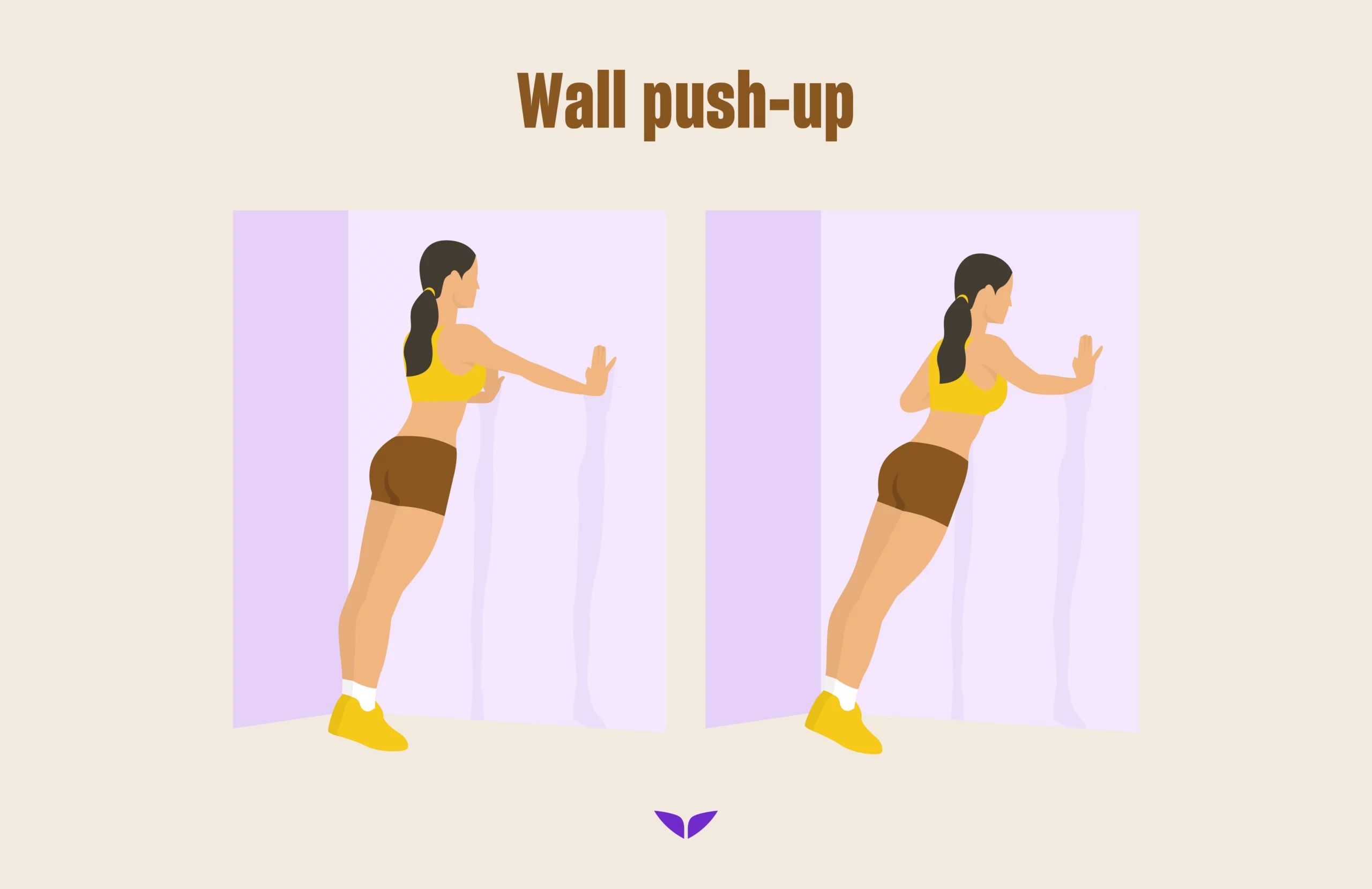
11. Plank
This seemingly simple exercise is a powerhouse for your back and core. It strengthens your entire posterior muscles, from your glutes and hamstrings to your lower and middle back. Plus, it improves your posture and stability.
Here’s how to do it:
- Start in a high plank position with your forearms on the ground and your body forming a straight line from head to heels.
- Engage your core and hold for as long as you can, maintaining proper form.
- Hold for 30 seconds, and then rest.
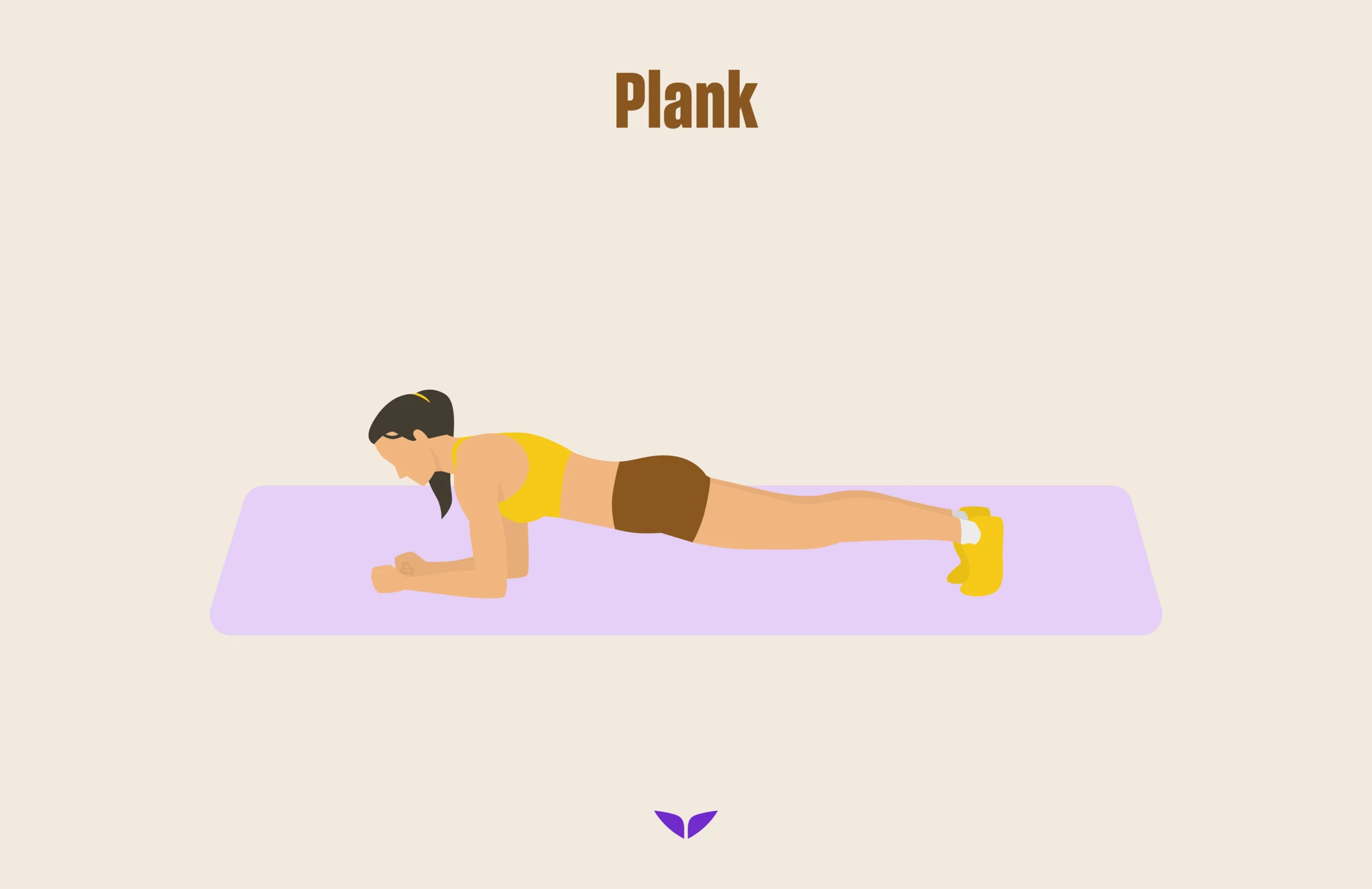
Bodyweight leg exercises
Strong legs are the foundation for everything you do. That’s why these bodyweight leg exercises go beyond the basics, challenging your quads, hamstrings, calves, and glutes for sculpted, powerful legs that will carry you further.
12. Jump squats
Get your heart pumping and your legs burning with this explosive exercise. It works your quads, hamstrings, and glutes, building power and coordination.
Here’s how to do it:
- Stand with feet shoulder-width apart, then squat down.
- As you explode upward, jump as high as you can.
- Land softly and immediately go into the next squat.
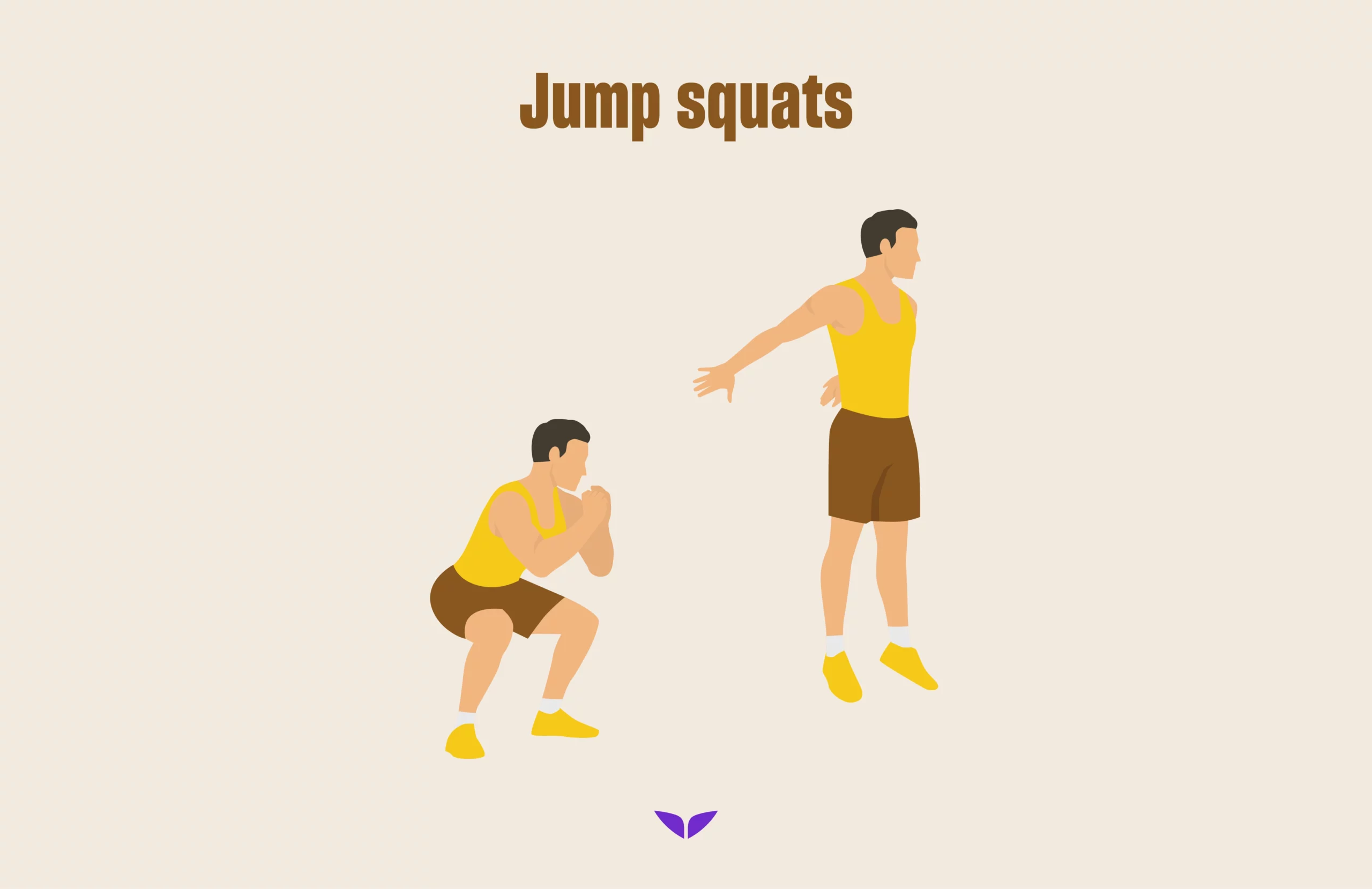
13. Single-leg squat
Forget ho-hum squats; embrace the single-leg challenge. This exercise builds unilateral strength and balance, working your quads, glutes, and hamstrings in a whole new way.
Here’s how to do it:
- Stand tall, then lift one leg off the ground and extend it straight behind you.
- Lower yourself down into a squat with the other leg, keeping your core engaged and your back straight.
- Push through your heel to stand back up.
- Repeat with the other leg.
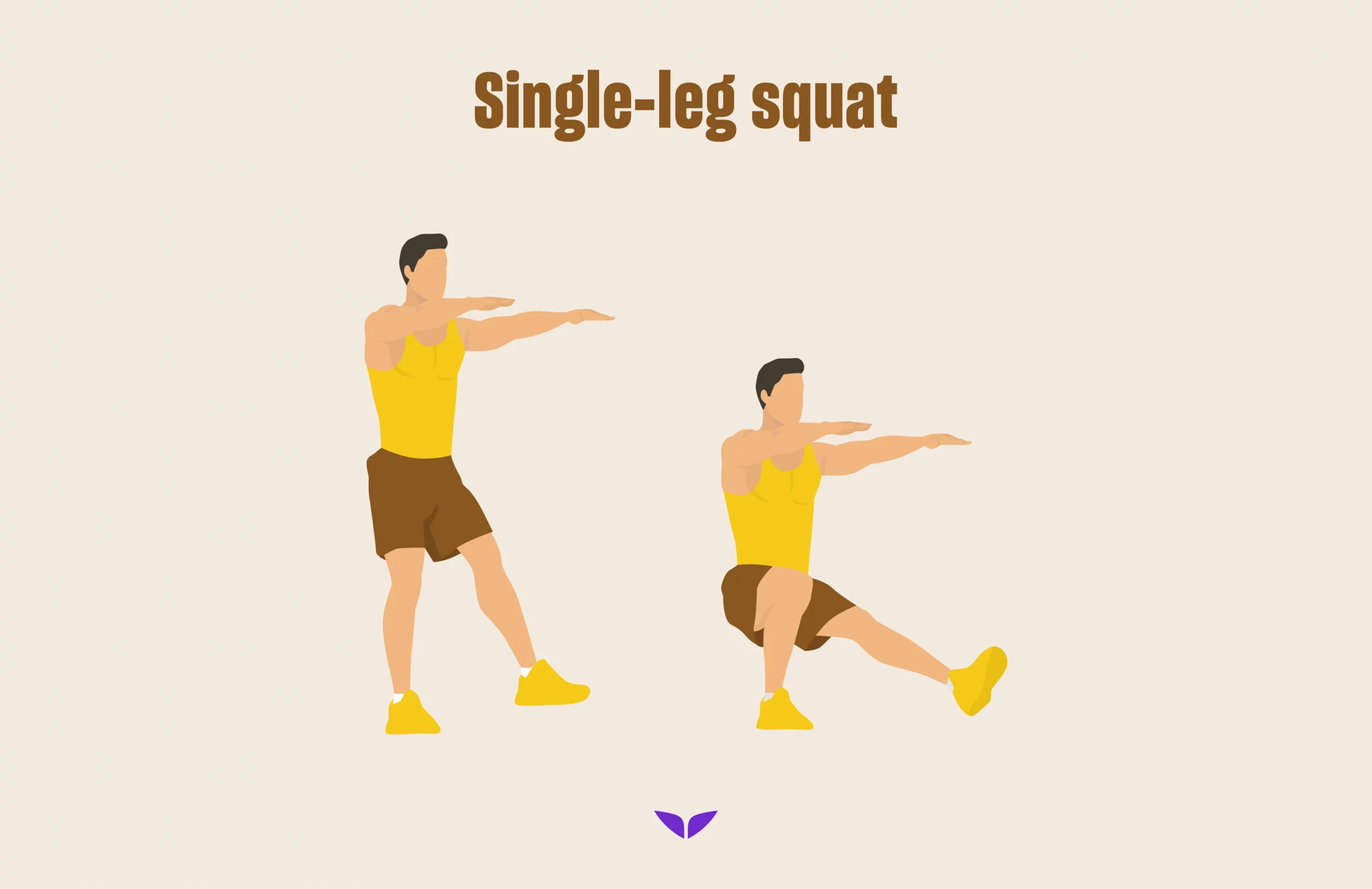
14. Box step-up
No gym? No problem. This exercise uses an elevated surface like a bench or stair to challenge your quads, glutes, and calves, building explosive power and coordination.
Here’s how to do it:
- Stand facing a step or box.
- Step up onto the box with one leg, bringing your other leg up to join it.
- Step back down with the same leg, then repeat with the other side.
- Keep your core engaged and avoid hunching your back.
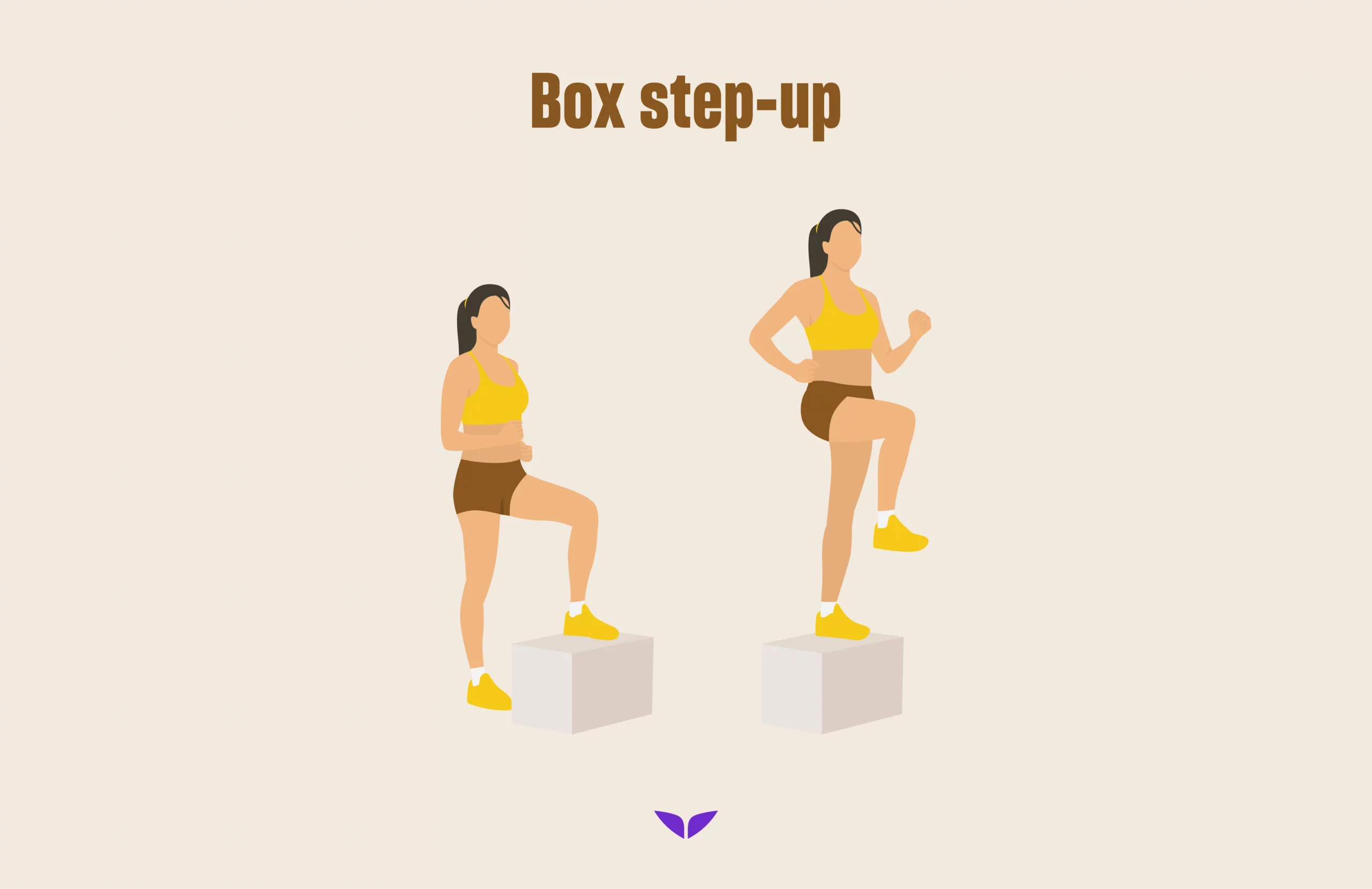
15. Calf raises
These often-neglected muscles add definition and power to your lower legs. Calf raises target your calves specifically, giving you that extra lift in your step.
Here’s how to do it:
- Stand with feet shoulder-width apart.
- Rise up onto your toes, squeezing your calves at the top.
- Hold for a second, then slowly lower your heels back down.
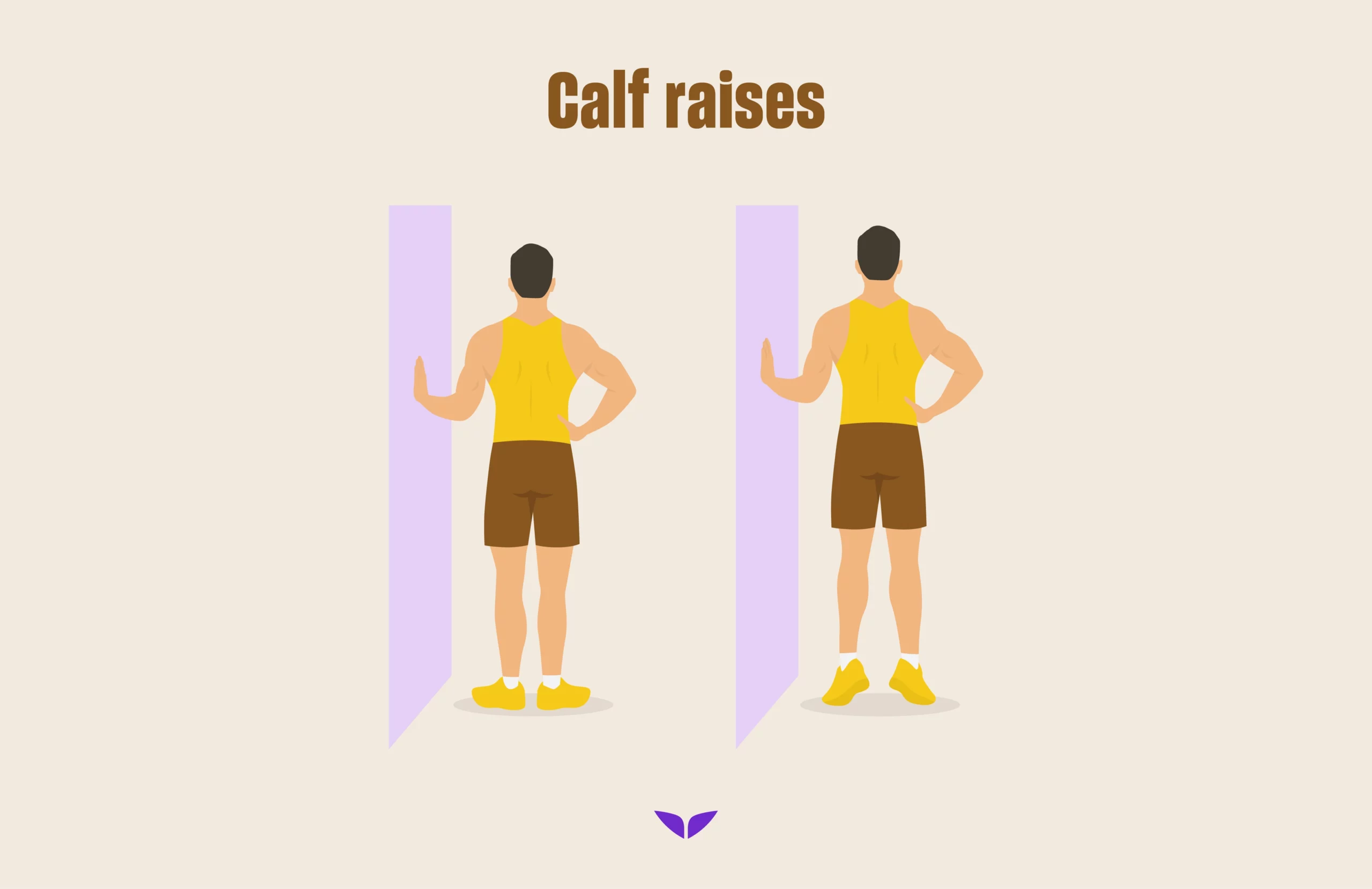
16. Sideways shuffle
You might look like a crab doing this, but it’s an exercise that helps build strength and stability in your lower body. This dynamic exercise works your inner and outer thighs, glutes, and calves, improving agility and coordination with a fun twist.
Here’s how to do it:
- Stand with feet hip-width apart.
- Take small steps to the side, keeping your feet flat on the ground and your core engaged.
- Shuffle back and forth for a set amount of time or repetitions.
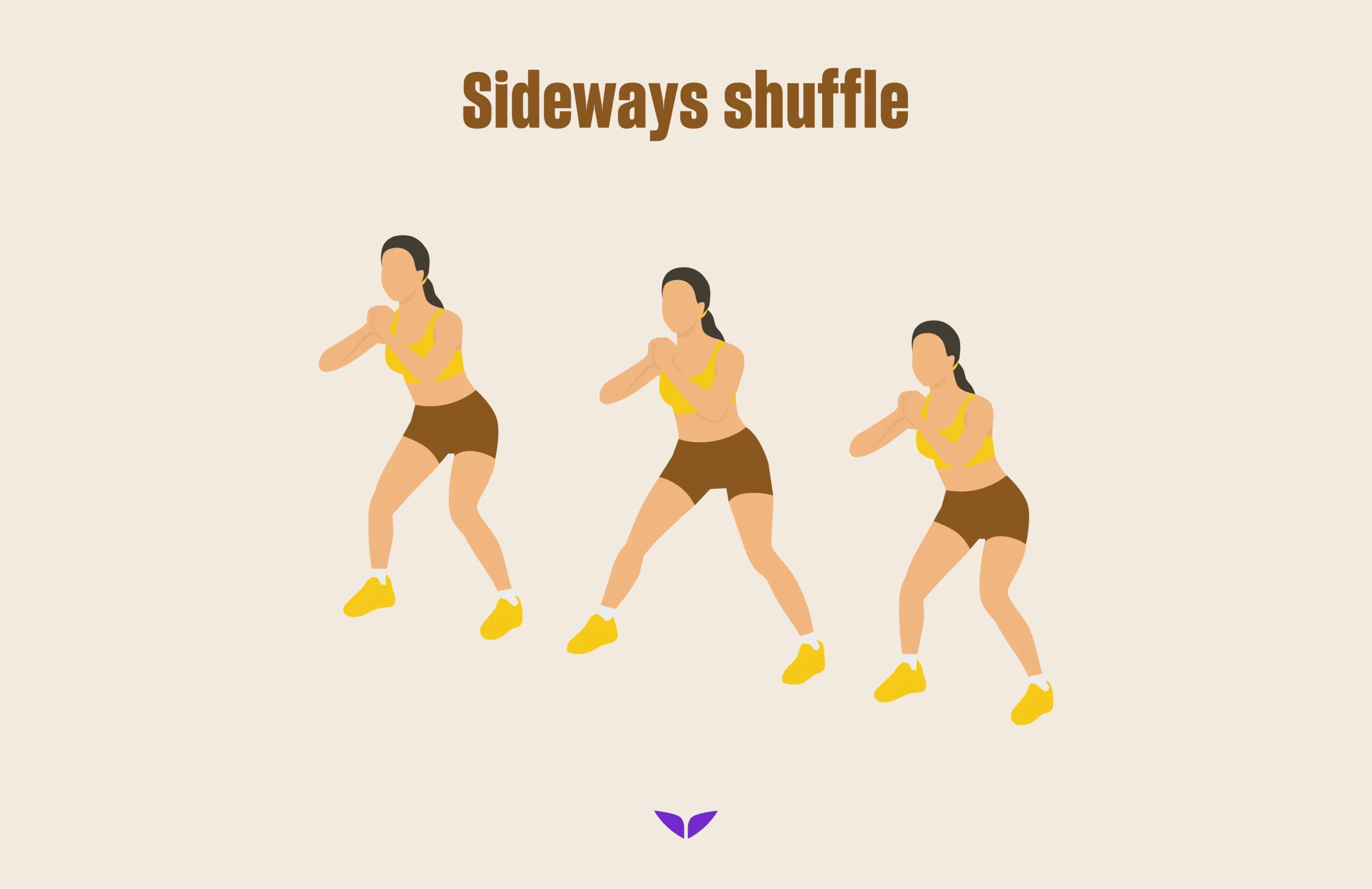
Bodyweight bicep exercises
“The beach is that way,” you say as you flex your guns, er, biceps. Sure, having impressive biceps can be purely about aesthetics, but it really has to do with everyday strength and functionality.
17. Isometric bicep hold
Think holding your grocery bags feels easy? Try isometric holds. This exercise uses a barbell (or dumbbells, if you have them) to target your biceps statically, improving strength and control.
Note: If you don’t have access to equipment, you can still perform an isometric bicep hold using household items. Find two objects of similar weight, such as water jugs, textbooks, or canned goods.
Here’s how to do it:
- Stand tall with your feet shoulder-width apart.
- Hold a barbell comfortably in front of your thighs with an underhand grip (palms facing up).
- Bend your elbows, as if curling the weight towards your shoulders, but stop halfway. Imagine you’re trying to curl the weight, but it’s stuck.
- Squeeze your biceps and hold this position for 30 seconds, feeling the tension in your muscles.
- Relax and slowly lower the barbell back to the starting position.
- Repeat for 2-3 sets.
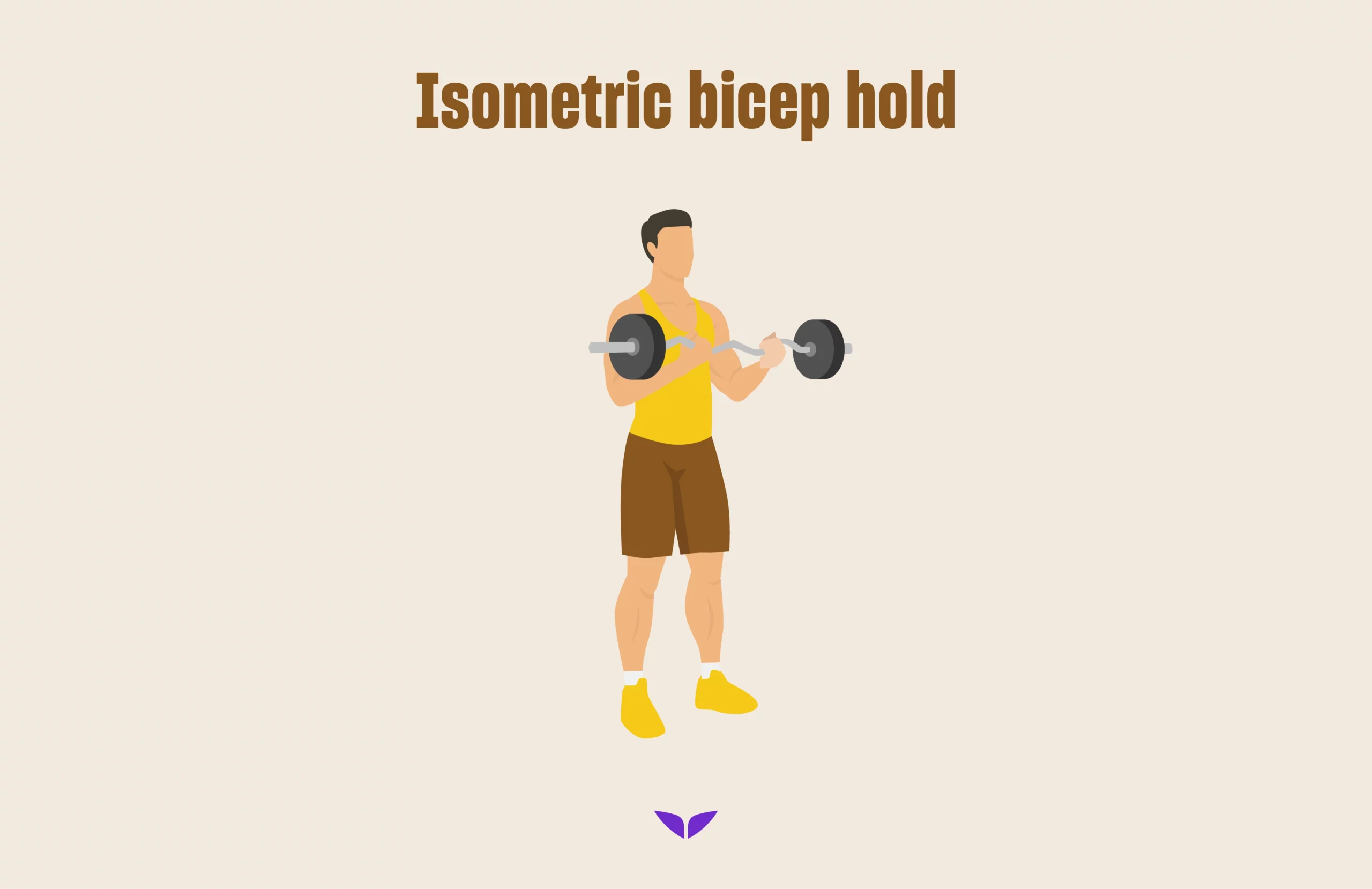
18. Bicep curls
Sometimes the classics are best. This simple bodyweight bicep curl is perfect for beginners or as a warm-up, building strength and definition.
You can use dumbbells if you’ve got them. Alternatively, you can use filled water bottles or cans.
Here’s how to do it:
- Stand tall with feet shoulder-width apart and arms at your sides.
- Curl your chosen weights towards your shoulders, focusing on squeezing your biceps at the top.
- Lower back down with control.
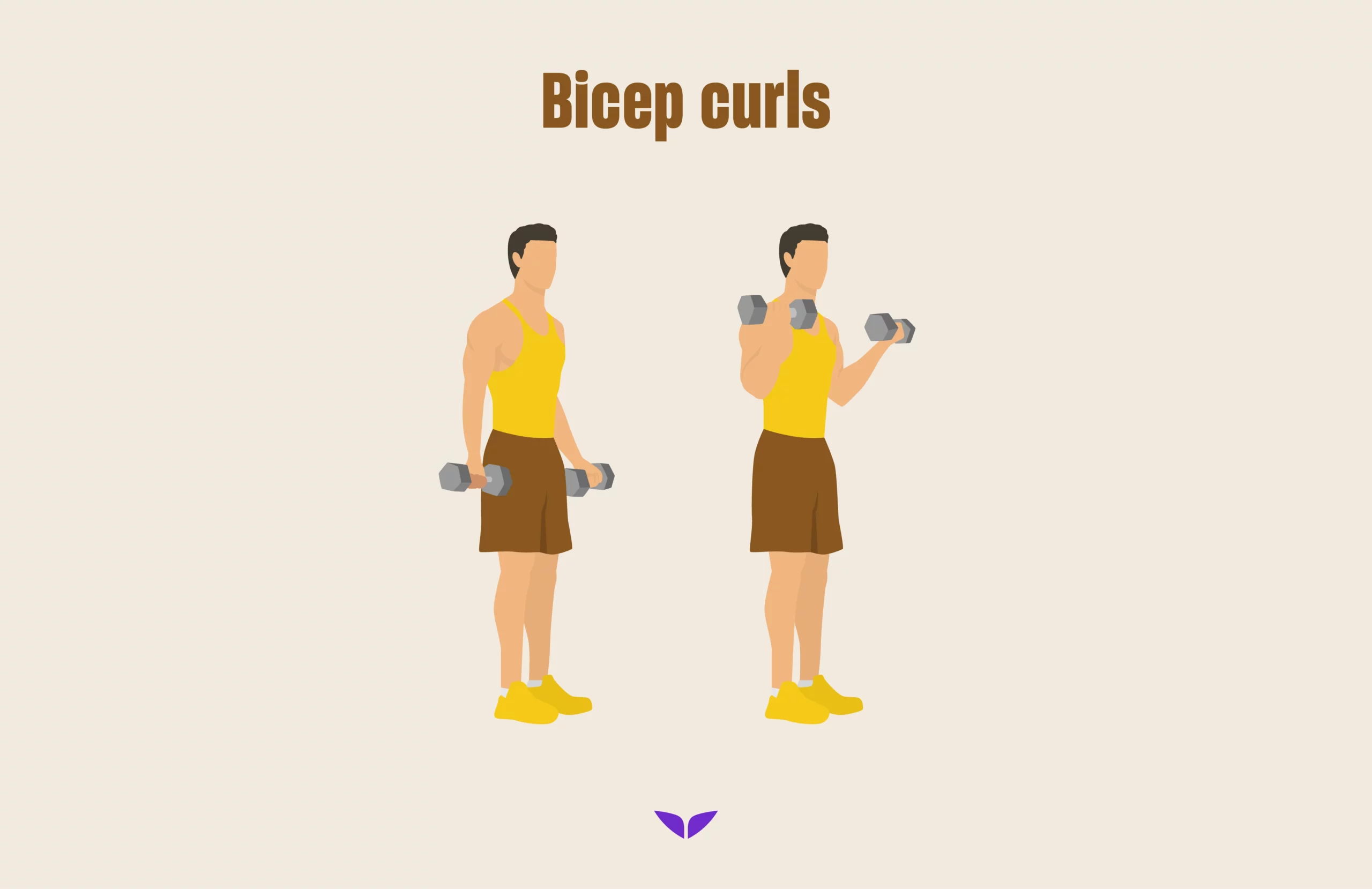
19. Negative bicep curls
Think lowering weights is easy? You may want to think again. Negative bicep curls focus on the lowering phase, building eccentric strength and muscle definition.
Here’s how to do it:
- Stand with your feet shoulder-width apart and hold your chosen weights in each hand.
- Curl the weights towards your shoulders, then slowly lower them down for five seconds, focusing on controlled movement.
- Repeat for several reps.
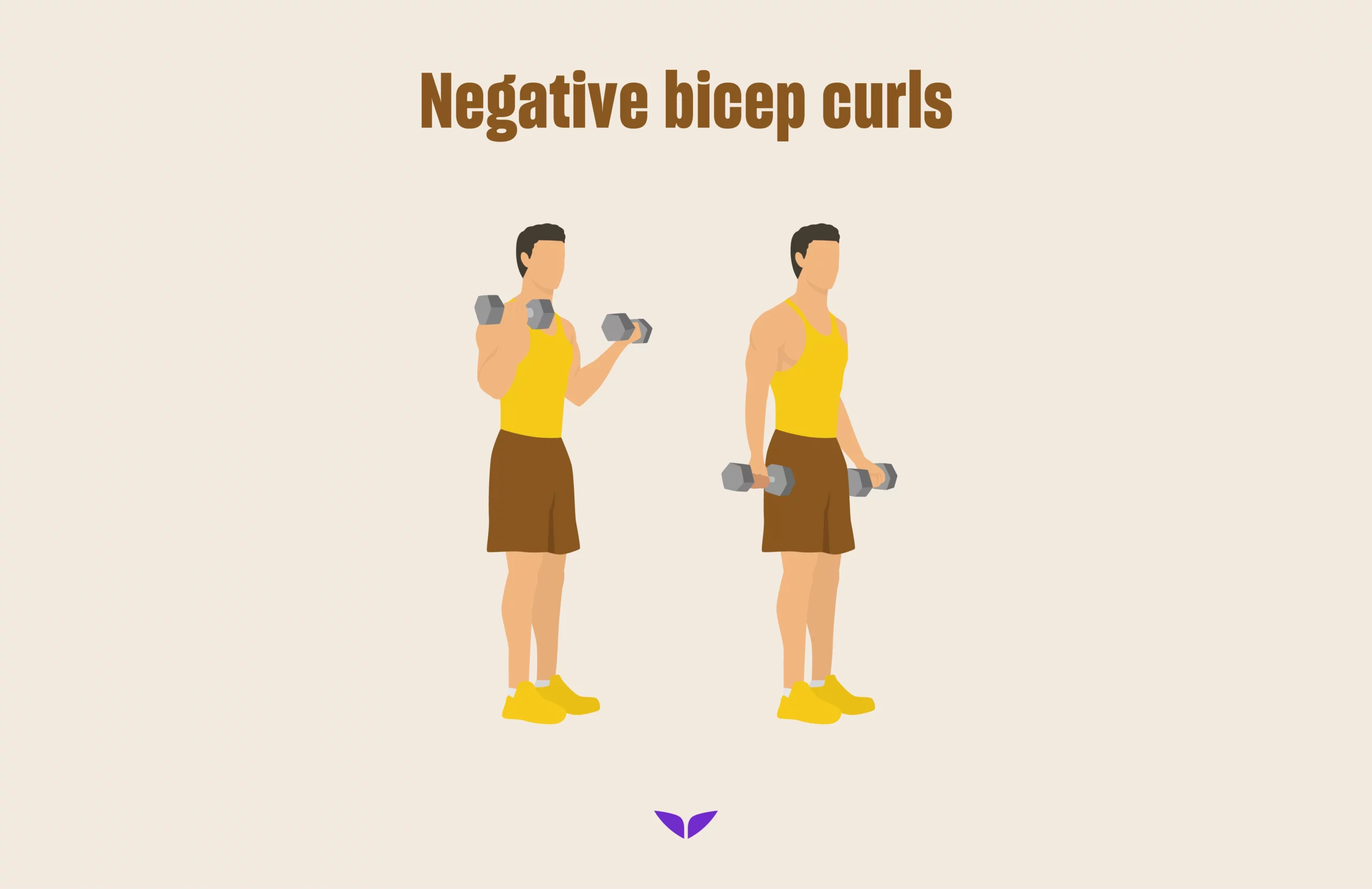
20. Hammer curls
If you want to ramp up the bicep curl, grab some (imaginary) hammers. This movement works your biceps from a different angle, incorporating your forearms for a more functional workout.
As with its classic counterpart, you can opt for dumbbells, filled water bottles, or cans (or even hammers, if you please).
Here’s how to do it:
- Stand tall with your feet shoulder-width apart.
- Hold your chosen weights at your sides, palms facing inward.
- Curl your forearms towards your shoulders, rotating your palms inward as you go.
- Squeeze at the top, then slowly lower back down.
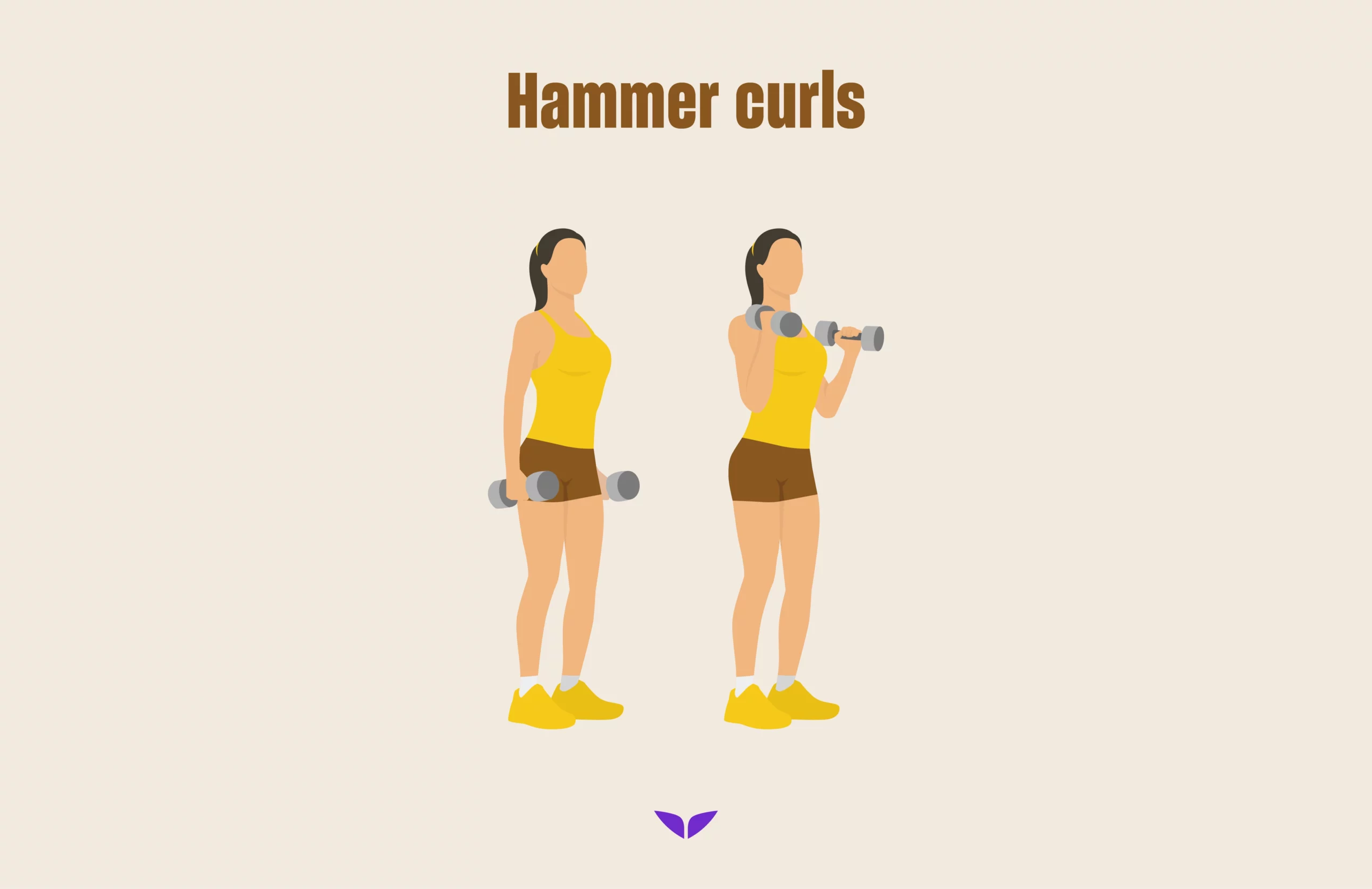
21. Wall walks
Who needs fancy equipment when you have a wall? This bodyweight exercise combines a bicep workout with a balance challenge, engaging your core and biceps for a dynamic upper-body workout.
Here’s how to do it:
- Stand facing a wall with your hands shoulder-width apart, fingertips lightly touching the wall.
- Walk your hands up the wall, keeping your body in a straight line and core engaged.
- As you reach your highest point, squeeze your biceps and hold for a second.
- Slowly walk your hands back down and repeat.
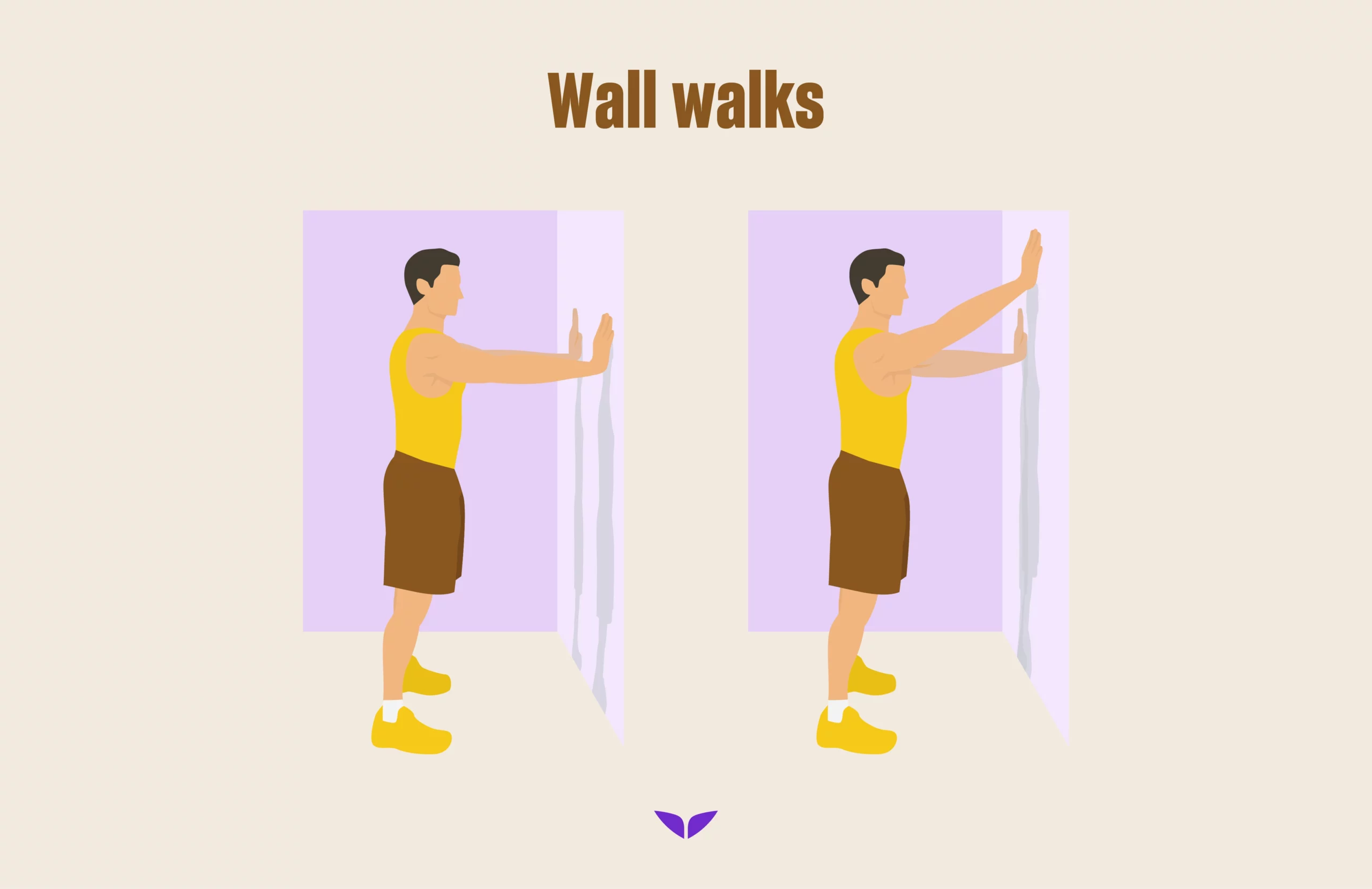
Frequently asked questions
How to build muscle with bodyweight exercises
When it comes to muscle building, there’s a whole science behind it. But simply put, here’s how Ronan explains it:
Your muscles are made of muscle fibers, and there are three main types:
- Slow twitch: Used for low-intensity activities like walking, they fatigue slowly.
- Fast twitch type A: Kick in for moderate intensity, like carrying groceries, and fatigue moderately fast.
- Fast twitch type B: Exert the most force but fatigue very quickly, like sprinting.
Muscle growth happens when you challenge your muscles beyond their usual capacity. And to do so, you need to target all these fibers.
By progressively increasing the intensity of your bodyweight exercises (reps, sets, and variations), you damage these fibers slightly. Your body repairs them, making them stronger and bigger. And this is why rest and proper nutrition are crucial for muscle growth.
How long does it take to build muscle with bodyweight exercises?
Muscle building is a gradual process, and results can vary significantly depending on your genetics, diet, training experience, and the specific exercises you choose. The good news is, while there isn’t a one-size-fits-all answer, research suggests that noticeable changes in muscle definition and strength can be achieved within 6–12 weeks of consistent bodyweight training.
One study involving a push-pull-legs resistance training program (similar to many bodyweight routines) showed that some participants (“high responders”) gained an average of 4.5 kg of muscle mass after 12 weeks, while others (“low responders”) gained an average of 1.2 kg. This highlights the potential for significant muscle growth with bodyweight exercises but also acknowledges individual differences.
How many reps for bodyweight exercises?
It really depends on your individual fitness level, training goals, and the specific exercise. Here’s a general breakdown:
- Beginners: Start with 8–12 reps per set, focusing on proper form and technique. As you become more comfortable, gradually increase the intensity by adding reps or variations.
- Intermediate: Aim for 12–15 reps per set, pushing closer to muscular failure. Experiment with different intensities and exercise variations to challenge your muscles further.
- Advanced: Target 15-20 reps per set, incorporating challenging variations and aiming for muscular failure within that rep range.
While reps play a role, Ronan emphasizes reaching muscular failure for effective bodyweight workouts. This means pushing yourself until your muscles can’t perform another rep with good form.
“You don’t stop when you feel you’re getting tired; you don’t stop when the leg muscles are burning a little bit,” says Ronan. “You stop when you are squatting down, and you cannot possibly push yourself off the ground.”
Why does it matter?
Aiming for muscular failure engages all the types of muscle fibers, which are crucial for muscle growth and strength gains. Additionally, when you stress your muscles, it prompts them to repair and rebuild stronger, leading to muscle growth and improved performance.
What are the benefits of bodyweight exercises?
There are a number of pluses when you opt for bodyweight exercises. Here are a few:
- Accessibility. No gym required. You can work out anywhere, anytime.
- Cost-effective. No equipment needed, making it a budget-friendly option.
- Functional strength. It builds strength and mobility relevant to everyday activities.
- Variety. You can explore various exercises to target different muscle groups and keep your workouts engaging.
- Lower impact. It’s more gentle on your joints compared to some weighted exercises.
The thing is, your body is a gym waiting to be explored. No weights, no limits, just pure potential.
Awaken your unstoppable
“What if all that fitness is to prepare you for moments in life when it really matters?” Ronan Diego reminds us. Don’t wait for those moments.
You can build your foundation today with Mindvalley’s free 10x Fitness Masterclass. In the 60-minute session, you’ll learn strategies to overcome time constraints and stay motivated, the most effective exercise for optimal results, and so much more.
It’s time to discover the possibilities that await.
Welcome in.
